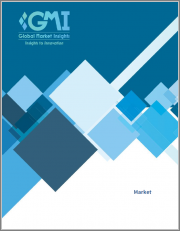
해상 보안 시장 규모는 세계 무역의 지속적인 확대에 힘입어 2024년부터 2032년까지 연평균 6% 이상의 성장률을 보일 것으로 예상됩니다.
국제 무역이 급증하면서 해상 항로, 항만, 선박의 안전 확보에 대한 관심이 높아지고 있습니다. 세계 각국의 정부와 해양 이해관계자들은 새로운 위협에 대응하고 물류의 흐름을 방해하지 않기 위해 첨단 보안 기술에 많은 투자를 하고 있습니다. 예를 들어, 2023년 3월 AD Ports Group은 아랍에미리트 내 사업 전반에 걸쳐 해상 안전을 개선하기 위해 선박교통관리정보시스템(VTMIS)을 도입한다고 발표했습니다.
또한, 지정학적 긴장과 영토 분쟁의 증가는 해상 보안의 필요성을 강조하고 각국이 보호를 위한 첨단 기술에 투자하도록 유도하고 있습니다. 무역 역학이 확대됨에 따라 해상 보안을 강화하기 위한 확고한 약속은 업계의 전망을 확대할 것으로 보입니다.
해상 보안 산업은 유형, 기술, 구성요소, 지역으로 구분됩니다.
기술별로 보면 스크리닝 및 스캐닝 분야의 시장 가치는 2024년부터 2032년까지 CAGR 8% 이상의 높은 성장률을 기록할 것으로 예상됩니다. 스크리닝 및 스캐닝 기술은 밀수품, 마약, 불법 무기 밀수 등 불법 행위를 탐지하고 예방하는 데 중요합니다. 잠재적 위협을 식별하고 차단하는 능력은 해양 업무의 전반적인 보안에 기여합니다. 또한, 전 세계 여러 정부와 해양 조직은 최첨단 선별 및 스캐닝 기술에 많은 투자를 하고 있으며, 해상 보안 프레임워크를 강화하여 이 분야의 성장을 지원하고 있습니다.
구성별로는 하드웨어 부문의 해상 보안 시장은 2024-2032년 연평균 5% 이상의 CAGR을 기록할 것으로 예상됩니다. 해상 위협의 복잡성으로 인해 감시 시스템, 센서, 레이더, 통신 장비와 같은 고급 하드웨어 솔루션에 대한 수요가 증가하고 있습니다. 다양한 기술의 발전으로 실시간 모니터링, 데이터 분석 및 신속한 대응 능력을 제공하는 통합 하드웨어 솔루션의 채택이 확대되고 있습니다. 또한, 포괄적이고 기술적으로 정교한 해양 안보 프레임워크로의 전략적 전환에 따른 하드웨어 투자 급증은 이 분야의 확장을 촉진할 것으로 보입니다.
지역별로 보면 아시아태평양의 해상 보안 산업은 2023년 상당한 매출 비중을 차지할 것으로 예상되며, 2024년부터 2032년까지 7% 이상의 성장률을 보일 것으로 예상됩니다. 남중국해, 말라카 해협 등 세계 무역에 필수적인 주요 항로의 존재는 주요 항로를 해적 행위로부터 보호하고 안전한 항해를 보장하기 위한 해상 보안 솔루션의 채택을 확대하는 데 기여하고 있습니다. 또한 이 지역의 경제 성장과 해상 교통량 증가는 해안 감시 강화, 항만 보안 강화, 첨단 기술 도입에 대한 강력한 이니셔티브를 촉진하여 이 지역의 산업 확장을 더욱 가속화하고 있습니다. 예를 들어, 2022년 3월, 4개국 정상은 회원국들이 불법 조업을 감시하고, 암흑 해운을 탐지하고, 기타 전술적 수준의 행동을 할 수 있도록 해양 안보 협력을 포함한 여러 조치를 시작했습니다.
Maritime Security Market size is poised to expand at more than 6% CAGR from 2024 to 2032 propelled by the relentless expansion of global trade. The surging international commerce is heightening the focus on safeguarding maritime routes, ports, and vessels. Multiple governments and maritime stakeholders worldwide are investing significantly in advanced security technologies to counter emerging threats and ensure the uninterrupted flow of goods. For instance, in March 2023, AD Ports Group announced the implementation of a vessel traffic management information system (VTMIS) to improve maritime safety throughout its UAE operations.
Moreover, the rising geopolitical tensions and territorial disputes are emphasizing the need for maritime security, prompting nations to invest in advanced technologies for protection. This steadfast commitment to fortifying maritime security owing to the expanding trade dynamics will augment the industry outlook.
The maritime security industry is segmented into type, technology, component, and region.
Based on technology, the market value from the screening & scanning segment is expected to record substantial growth at over 8% CAGR from 2024 to 2032. Screening and scanning technologies are important for detecting and preventing illicit activities, including the smuggling of contraband goods, drugs, and illegal weapons. The ability to identify and intercept potential threats is contributing to the overall security of maritime operations. Furthermore, several governments and maritime organizations worldwide are investing heavily in cutting-edge screening and scanning technologies to fortify their maritime security frameworks, supporting the segment growth.
In terms of component, the maritime security market from the hardware segment is set to witness more than 5% CAGR during 2024-2032. The increasing complexity of maritime threats is propelling the demand for advanced hardware solutions, including surveillance systems, sensors, radars, and communication equipment. The evolution of various technologies is resulting in the growing adoption of integrated hardware solutions to offer real-time monitoring, data analytics, and rapid response capabilities. Additionally, the surge in hardware investments owing to the strategic shift towards comprehensive and technologically sophisticated maritime security frameworks is likely to foster the segment expansion.
Regionally, the Asia Pacific maritime security industry held a sizable revenue share in 2023 and is estimated to expand at over 7% growth rate between 2024 and 2032. The presence of critical sea routes, including the South China Sea and the Malacca Strait, vital for global trade is contributing to the rising adoption of maritime security solutions to protect key water routes against piracy and guarantee secure sailing. Moreover, the expanding economies and increasing maritime traffic in the region are prompting robust initiatives to fortify coastal surveillance, enhance port security, and deploy advanced technologies, further accelerating the regional industry expansion. For instance, in March 2022, the Quad leaders launched several measures, including a marine security collaboration to enable member nations to monitor illicit fishing, detect dark shipping, and engage in other tactical-level actions.